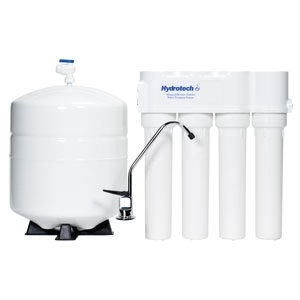


Proper water filtration is essential for every residential & commercial setting. Here’s why to install a 4-stage reverse osmosis system for pure water.
Access to safe and pure water is crucial for public health, regardless of the purpose for which it is used. Whether for drinking, household needs, food production, or recreational activities, clean water supports hydration and prevents waterborne diseases, ensuring overall well-being. Keeping this in mind, people these days seek effective filtration solutions that can enhance the water quality.
Among plenty of water filtration options, a 4-stage reverse osmosis system stands out for its ability to remove contaminants and produce pure, healthy water. For example, Hydrotech 4VTFC50G 4 Stage 50 GPD Reverse Osmosis System. Indeed, it’s a reliable and efficient method to promote a healthier lifestyle.
Any idea, what exactly is a 4-stage RO system, and how it works? Let’s dive into the article to understand the role of this filter in improving water quality.
As the name suggests, a 4-stage RO system follows a multi-step water filtration process to filter tap water using a semi-permeable membrane. In every stage, the filter removes different types of contaminants including dissolved salts, small particles, bacteria, water solvents, and other impurities.
What are the 4-Stages of Reverse Osmosis?
The following four stages of filtration display how exactly the RO system works.
The initial stage uses a sediment filter to capture larger particles like dirt, rust, and silt. This pre-filtration step protects the RO membrane from getting clogged by debris, ensuring that the system operates efficiently.
The second stage involves a carbon cartridge filter to trap several particles. These can be chlorine, volatile organic compounds, and other chemicals that can add an unpleasant taste and odor to water.
In the third stage, the system uses a reverse osmosis membrane. It is a semi-permeable membrane that removes 99% of total dissolved solids, heavy metals, and microorganisms like bacteria. Water passing through it is completely free from contaminants.
In the final stage or 4th stage, the post-carbon filter removes the traces of impurities and odors present in water. This enhances the taste and overall quality of water, keeping its freshness and purity intact.
Apart from superior and comprehensive filtration, an RO water filter offers a list of benefits. These include –
Contaminants in tap water are growing rapidly and so are the water borne diseases. This rising concern has triggered many households to turn to reverse osmosis water filtration systems to ensure safe health. Even industrial and commercial facilities do not compromise on this.
Many ecommerce platforms like Water Filters Fast offer high-quality water filters from trusted brands. Anyone looking forward to investing in these systems can explore these products and get the right one for the setting.
